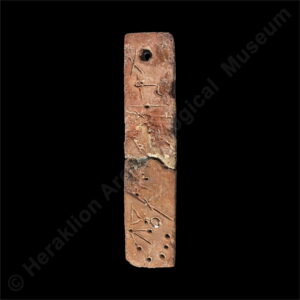
Cretan Hieroglyphic appeared in the late Protopalatial period, in the 18th century BC, and was used alongside Linear A until the beginning of the Neopalatial period. Although it remains undeciphered, we know that most of its signs were syllabograms, phonetically representing syllables. Some symbols were logograms, representing commodities such as wine, wheat, olives and textiles. Others corresponded to a decimal numerical system, units of measurement and their subdivisions. Cretan Hieroglyphic appears on a wide range of documents recording various transactions. Medallions and roundels were used for brief records, as were crescent-shaped sealings. Clay rectangular bars were probably tax records, as they often bear logograms and numbers.